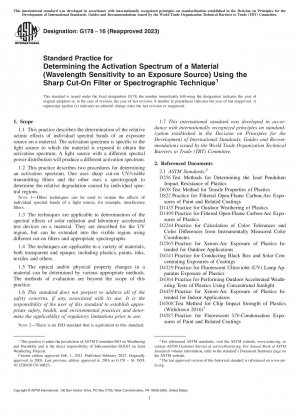ASTM G178-16(2023)
Standard Practice for Determining the Activation Spectrum of a Material (Wavelength Sensitivity to an Exposure Source) Using the Sharp Cut-On Filter or Spectrographic Technique
- Standard No.
- ASTM G178-16(2023)
- Release Date
- 2023
- Published By
- American Society for Testing and Materials (ASTM)
- Latest
- ASTM G178-16(2023)
- Scope
- 1.1 This practice describes the determination of the relative actinic effects of individual spectral bands of an exposure source on a material. The activation spectrum is specific to the light source to which the material is exposed to obtain the activation spectrum. A light source with a different spectral power distribution will produce a different activation spectrum. 1.2 This practice describes two procedures for determining an activation spectrum. One uses sharp cut-on UV/visible transmitting filters and the other uses a spectrograph to determine the relative degradation caused by individual spectral regions. NOTE 1—Other techniques can be used to isolate the effects of individual spectral bands of a light source, for example, interference filters. 1.3 The techniques are applicable to determination of the spectral effects of solar radiation and laboratory accelerated test devices on a material. They are described for the UV region, but can be extended into the visible region using different cut-on filters and appropriate spectrographs. 1.4 The techniques are applicable to a variety of materials, both transparent and opaque, including plastics, paints, inks, textiles and others. 1.5 The optical and/or physical property changes in a material can be determined by various appropriate methods. The methods of evaluation are beyond the scope of this practice. 1.6 This standard does not purport to address all of the safety concerns, if any, associated with its use. It is the responsibility of the user of this standard to establish appropriate safety, health, and environmental practices and determine the applicability of regulatory limitations prior to use. NOTE 2—There is no ISO standard that is equivalent to this standard. 1.7 This international standard was developed in accordance with internationally recognized principles on standardization established in the Decision on Principles for the Development of International Standards, Guides and Recommendations issued by the World Trade Organization Technical Barriers to Trade (TBT) Committee.
ASTM G178-16(2023) Referenced Document
- ASTM D1435 Standard Practice for Outdoor Weathering of Plastics
- ASTM D1499 Standard Practice Filtered Open-Flame Carbon-Arc Type Exposures of Plastics
- ASTM D2244 Standard Test Method for Calculation of Color Differences From Instrumentally Measured Color Coordinates
- ASTM D256 Standard Test Methods for Determining the Izod Pendulum Impact Resistance of Plastics*, 2023-03-15 Update
- ASTM D2565 Standard Practice for Xenon-Arc Exposure of Plastics Intended for Outdoor Applications
- ASTM D4141 Standard Practice for Conducting Black Box and Solar Concentrating Exposures of Coatings
- ASTM D4329 Standard Practice for Fluorescent UV Exposure of Plastics
- ASTM D4364 Standard Practice for Performing Outdoor Accelerated Weathering Tests of Plastics Using Concentrated Sunlight
- ASTM D4459 Standard Practice for Xenon-Arc Exposure of Plastics Intended for Indoor Applications
- ASTM D4508 Standard Test Method for Chip Impact Strength of Plastics
- ASTM D4587 Standard Practice for Fluorescent UV-Condensation Exposures of Paint and Related Coatings
- ASTM D5031 Standard Practice for Enclosed Carbon-Arc Exposure Tests of Paint and Related Coatings
- ASTM D6360 Standard Practice for Enclosed Carbon-Arc Exposures of Plastics
- ASTM D638 Standard Test Method for Tensile Properties of Plastics
- ASTM D6695 Standard Practice for Xenon-Arc Exposures of Paint and Related Coatings*, 2024-04-21 Update
- ASTM D822 Standard Practice for Filtered Open-Flame Carbon-Arc Exposures of Paint and Related Coatings
- ASTM E275 Standard Practice for Describing and Measuring Performance of Ultraviolet, Visible, and Near-Infrared Spectrophotometers
- ASTM E313 Standard Practice for Calculating Yellowness and Whiteness Indices from Instrumentally Measured Color Coordinates
- ASTM E925 Standard Practice for Monitoring the Calibration of Ultraviolet-Visible Spectrophotometers whose Spectral Slit Width does not Exceed 2 nm
- ASTM G113 Standard Terminology Relating to Natural and Artificial Weathering Tests of Nonmetallic Materials
- ASTM G147 Standard Practice for Conditioning and Handling of Nonmetallic Materials for Natural and Artificial Weathering Tests
- ASTM G152 Standard Practice for Operating Open Flame Carbon Arc Light Apparatus for Exposure of Nonmetallic Materials*, 2024-04-21 Update
- ASTM G153 Standard Practice for Operating Enclosed Carbon Arc Light Apparatus for Exposure of Nonmetallic Materials
- ASTM G154 Standard Practice for Operating Fluorescent Ultraviolet (UV) Lamp Apparatus for Exposure of Materials
- ASTM G155 Standard Practice for Operating Xenon Arc Lamp Apparatus for Exposure of Materials*, 2024-04-21 Update
- ASTM G24 Standard Practice for Conducting Exposures to Daylight Filtered Through Glass
- ASTM G7 Standard Practice for Atmospheric Environmental Exposure Testing of Nonmetallic Materials
- ASTM G90 Standard Practice for Performing Accelerated Outdoor Weathering of Nonmetallic Materials Using Concentrated Natural Sunlight
ASTM G178-16(2023) history
- 2023 ASTM G178-16(2023) Standard Practice for Determining the Activation Spectrum of a Material (Wavelength Sensitivity to an Exposure Source) Using the Sharp Cut-On Filter or Spectrographic Technique
- 2016 ASTM G178-16 Standard Practice for Determining the Activation Spectrum of a Material (Wavelength Sensitivity to an Exposure Source) Using the Sharp Cut-On Filter or Spectrographic Technique
- 2009 ASTM G178-09 Standard Practice for Determining the Activation Spectrum of a Material (Wavelength Sensitivity to an Exposure Source) Using the Sharp Cut-On Filter or Spectrographic Technique
- 2003 ASTM G178-03 Standard Practice for Determining the Activation Spectrum of a Material (Wavelength Sensitivity to an Exposure Source) Using the Sharp Cut-On Filter or Spectrographic Technique
